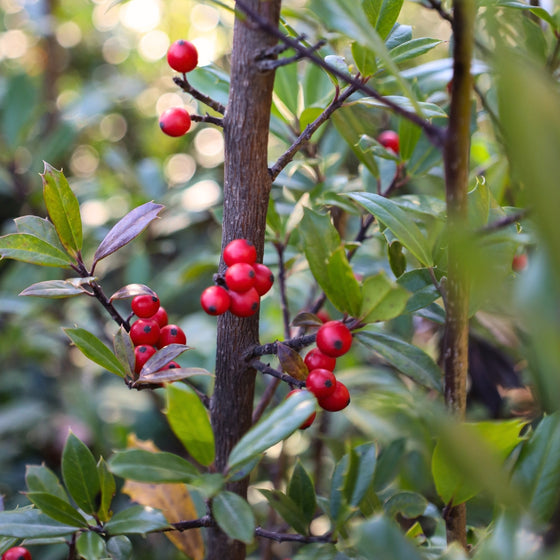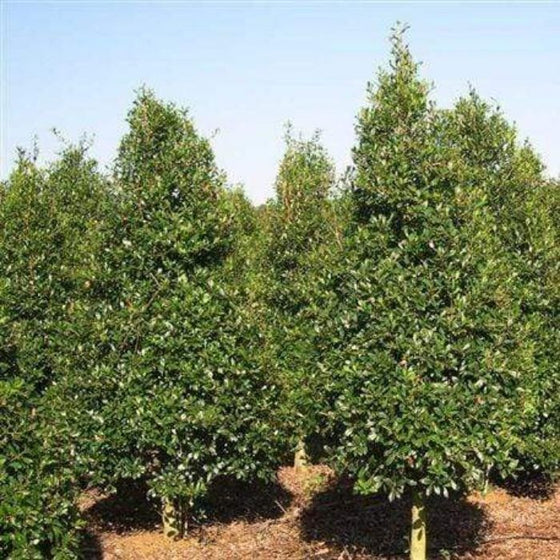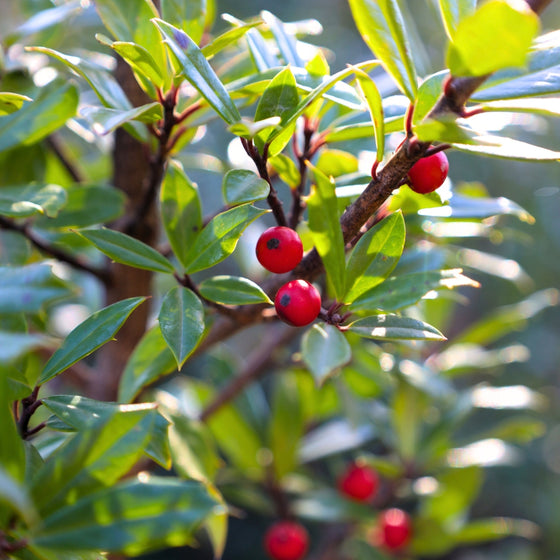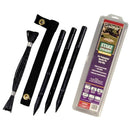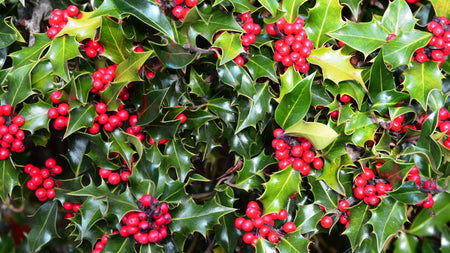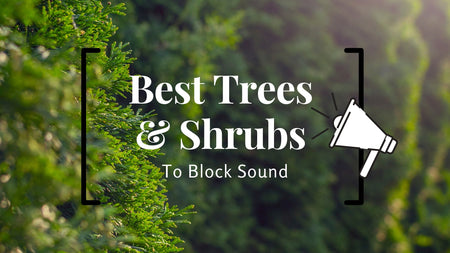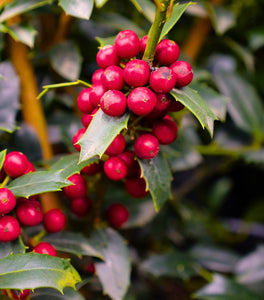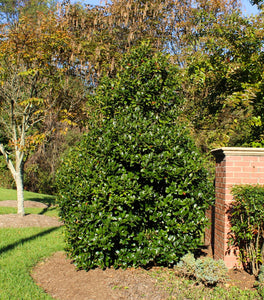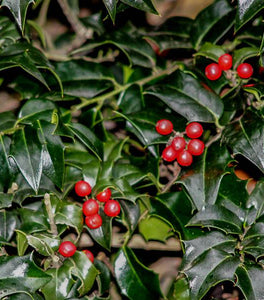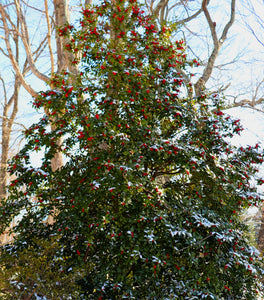
Images Depict Mature Plants
Foster Holly Tree for Sale Online
The Foster Holly is an elegant evergreen shrub known for its dense, glossy green foliage and striking red berries that add year-round beauty to any landscape. Growing 15-25 feet tall and 5-10 feet wide at maturity, this pyramidal holly is ideal for use as a privacy screen, hedge, or even as a standalone specimen tree. Its rich, dark green leaves stay vibrant throughout the year, while clusters of bright red berries appear in fall, lasting through winter, making it a perfect option for seasonal interest. Hardy in USDA Zones 6-9, Foster Holly thrives in a variety of climates and is well-suited for gardens in both mild and cooler regions.
Foster Holly is not only visually appealing but also incredibly low-maintenance. It prefers full sun to partial shade and well-drained soil, making it adaptable to different planting locations. Once established, this holly is drought-tolerant and requires minimal care beyond occasional watering during dry periods. The dense foliage provides excellent privacy, making it a great choice for screening or creating natural borders. Additionally, Foster Holly is tolerant of urban pollution and can thrive in city environments, adding beauty and function to both suburban and urban landscapes.
A standout feature of the Foster Holly is its ability to attract wildlife. The red berries serve as a food source for birds in the colder months, while the dense foliage offers shelter and nesting sites. Its versatility, easy care, and year-round interest make Foster Holly an ideal choice for gardeners looking to add structure and color to their landscape, all while supporting local wildlife. Whether used as a hedge, privacy screen, or focal point, Foster Holly is a beautiful, functional, and hardy addition to any garden.

| Hardiness Zone: | 6-9 |
|---|---|
| Mature Height: | 15 to 25 Feet |
| Mature Width: | 5 to 10 Feet |
| Sunlight: | Full sun to part shade |
| Foliage Color: | Dark green |
| Growth Form: | Upright pyramidal |
| Soil Conditions: | Very tolerant of most soil conditions |
How to Care for Foster Holly
Be sure to read our planting instructions to ensure a healthy and happy Foster Holly for years to come!
How Do I Plant Foster Holly Trees?
To plant Foster Holly trees, start by selecting a location with well-drained soil that receives full sun to partial shade, as these conditions help the tree thrive. Dig a hole twice as wide and just as deep as the root ball to allow the roots room to spread. Place the Foster Holly tree in the hole, ensuring that the top of the root ball is level with the surrounding soil. After positioning the tree, backfill with a mix of native soil and organic compost to improve drainage and nutrient availability. Water the tree deeply after planting to help establish strong roots, and apply a 2-3 inch layer of mulch around the base to retain moisture and suppress weeds. Once planted, Foster Holly requires regular watering during the first growing season to promote healthy root development. Water deeply once or twice a week, ensuring the soil stays moist but not waterlogged. Over time, as the tree becomes established, it will become more drought-tolerant and require less frequent watering. Be sure to space multiple trees about 5-10 feet apart if planting a hedge or privacy screen to allow enough room for their mature size. With proper planting and initial care, Foster Holly will reward you with its glossy, evergreen foliage and bright red berries that add beauty and structure to your landscape year-round.
How Do I Water Foster Holly Trees?
To properly water Foster Holly trees, it’s important to keep the soil consistently moist, especially during the first year after planting. Water deeply once or twice a week, ensuring the water penetrates the root zone to help establish strong roots. During the growing season, it’s best to water at the base of the tree, avoiding wetting the leaves to prevent disease. In particularly hot or dry climates, you may need to increase the frequency of watering to ensure the soil doesn’t dry out completely, especially in the first few months after planting. Once your Foster Holly tree is established, it becomes more drought-tolerant and requires less frequent watering. However, during extended dry periods or in especially hot weather, deep watering every couple of weeks will help keep the foliage lush and healthy. Applying a 2-3 inch layer of mulch around the base of the tree can help retain moisture, reduce evaporation, and protect the roots from temperature fluctuations. Monitoring the soil and adjusting your watering schedule accordingly will ensure your Foster Holly thrives, producing its signature evergreen foliage and vibrant red berries.
How Do I Fertilize Foster Holly Trees?
To fertilize Foster Holly trees, apply a balanced, slow-release fertilizer in early spring just as new growth begins. A fertilizer with a 10-10-10 or 12-6-6 formula provides the essential nutrients—nitrogen, phosphorus, and potassium—needed to support healthy root development and vibrant foliage. Spread the fertilizer evenly around the base of the tree, making sure to keep it a few inches away from the trunk to avoid root burn. Water thoroughly after applying the fertilizer to help it absorb into the soil and reach the roots. This spring feeding helps ensure your Foster Holly grows strong and maintains its lush, evergreen appearance throughout the growing season. For ongoing nourishment, you can fertilize Foster Holly trees again in mid-summer, particularly if they are showing signs of nutrient deficiency, such as pale or stunted growth. Organic options, like compost or well-rotted manure, can also be added around the tree base to naturally enrich the soil. Avoid over-fertilizing, as too much nitrogen can lead to excessive growth and reduce berry production. By fertilizing your Foster Holly trees properly, you will encourage healthy growth, vibrant red berries, and year-round beauty in your landscape.

How Do I Prune Foster Holly Trees?
Pruning Foster Holly trees is important for maintaining their shape, encouraging healthy growth, and promoting berry production. The best time to prune is in late winter or early spring, just before new growth begins. Start by removing any dead, damaged, or diseased branches to improve air circulation and reduce the risk of pests or disease. Next, trim back any overgrown or uneven branches to maintain the tree’s natural pyramidal shape. Be cautious not to prune too much at once, as Foster Holly trees benefit from light, regular pruning rather than heavy cutting. If you're growing Foster Holly as a hedge or privacy screen, pruning the sides and top of the tree can help keep the hedge uniform and dense. When pruning, avoid cutting too far into older wood, as holly trees generally do not regrow from older branches. For optimal berry production, make sure to prune selectively to retain some of the older wood, where berries typically form. Regular pruning of your Foster Holly will enhance its overall health and maintain its striking appearance, with its glossy evergreen foliage and bright red berries providing year-round interest in your garden.

